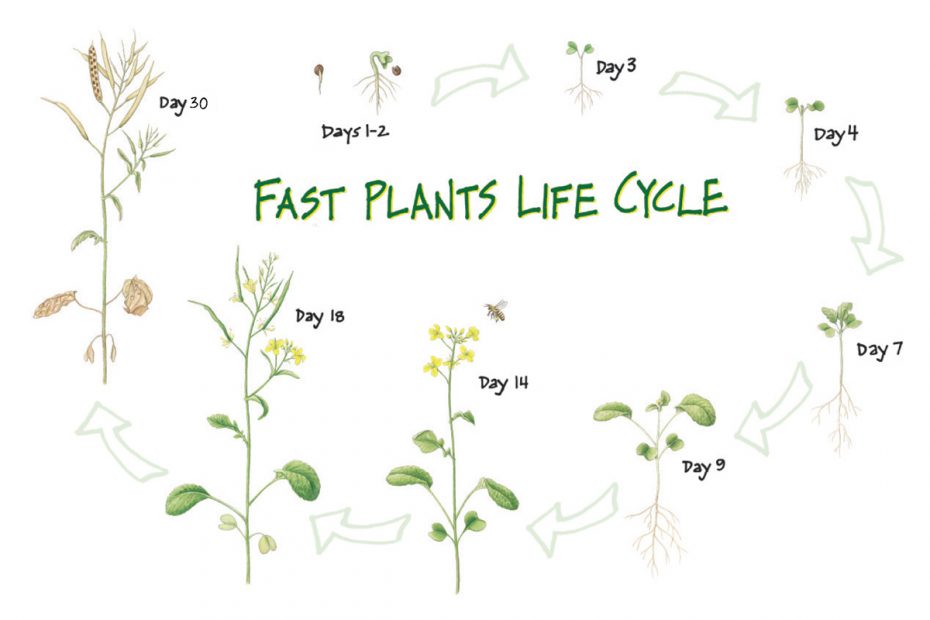Wisconsin Fast Plants® of the Department of Plant Pathology at UW-Madison are helping scientists explore how plants can thrive beyond Earth, and they’re paving the way for future space farming and sustainable life support systems in space. In fact, if you follow on Instagram #fastplantsinspace (@fastplants) we’ll be sharing about Fast Plants in flight on Blue Origin with Emily Calandrelli …
Seed Harvest – Identifying Mature Seeds
Producing Fast Plants seed for investigations that need offspring generations Seed harvest is an essential step in any Fast Plants experimental design that involves gathering evidence from offspring plants that students produce themselves. For example, you may have students conduct an inheritance investigation in which they inter-mate Fast Plants from an F1 generation to produce and observe the F2 offspring. …
Ecosystem dynamics investigations
Why hands-on ecosystem investigations? Ecosystems are highly complex systems; how can we support learners to grasp the effects on populations when one component of an ecosystem changes? Using a model ecosystem and model population in a hands-on investigation is an effective teaching strategy. In addition to making abstract ecosystem concepts more concrete, using Fast Plants as a model organism in …
Hands-on learning with Fast Plants grows minds-on learning
While occupied by hands-on Fast Plants tending tasks in my role as co-director of the Wisconsin Fast Plants Program, I often listen to podcasts. Spoiler alert: I love podcasts about plants! No surprise, one of my favorites is Matt Candeias’ podcast, In Defense of Plants. Beyond my fascination with the wide array of topics Matt dives into in his podcasts, I appreciate …
My first experience teaching with Fast Plants
Classroom teacher, Julie LaConte, tells about her first experience teaching with Fast Plants in this guest post. Thank you, Julie, for sharing your insights and experiences! Fall 2019 was my first experience teaching with Fast Plants, and plants are one of my least favorite topics to teach. After 18 years as an upper elementary and middle school science teacher, I have had my fair share …
NEW! ExploreLearning releases Wisconsin Fast Plant® simulation Gizmos®
Two Wisconsin Fast Plants® simulation Gizmos® were created as a collaboration between ExploreLearning and the Wisconsin Fast Plants Program. These simulations were designed to support a variety of investigations and growing Fast Plants. AND they replace the simulations created nearly two decades ago that can no longer function on modern operating systems! Simulations complement physically growing Fast Plants Using these Gizmos during or after growing Fast Plants, …
Investigations with Wisconsin Fast Plants lead to powerful learning
Teaching and Learning with Fast Plants Investigations We know it is important to “help students make sense of the natural world by designing and carrying out authentic, student driven investigations (Wingert & Bell, 2015).” Compared to other living organisms, Wisconsin Fast Plants are easy to manage and very responsive to factors in their environment. In addition, many easy-to-observe Fast Plant phenotypes …
Flowering and the Role of Vernalization
A plant’s transition from vegetative growth to reproductive/flowering growth is a complicated process. In order for a plant to complete its life cycle and produce viable seeds, flowering must occur under conditions that encourage seed production. Plants are able to detect a variety of internal and environmental signals that influence floral development. Internal signaling is via production and diffusion of …
Teaching with the Fast Plants life cycle
Life Cycle Investigations Life cycle investigations with Wisconsin Fast Plants® provide rich context for teaching and learning a broad range of concepts. Though some think of the plant life cycle as limited to elementary level lessons, investigations and observations made during the Fast Plants life cycle are used worldwide at middle, high school and college levels, too. Crosscutting Concepts and life cycles Try to …










